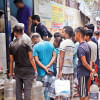Pirojpur in crisis
The people in half of Pirojpur district, according to a report in this paper on February 28, are facing the worst crisis imaginable – lack of safe drinking water. Water in most of the shallow tubewells, the main source of water for most of the villagers, have harmful levels of iron and many also have high deposits of arsenic. Meanwhile salinity has also made water in many deep tubewells undrinkable. People of these areas, therefore, have the choice of either drinking the water that contains harmful levels of these substances or from nearby ponds and canals which are also full of pathogens.
The unacceptable levels of iron, arsenic and salinity in the water supplies, as found by the public health department engineers, can cause serious damage to the lungs, kidneys, skin, liver and may also cause cancer, heart disease and other life-threatening conditions. Immediate steps, therefore, have to be taken to make water in tube wells – shallow and deep – drinkable again. The concerned ministry must take measures on an emergency basis, to set up a desalination water purification plant and other infrastructure that removes arsenic and iron from the water. Rainwater harvesting measures may also be explored as one of the ways to store drinkable water.
Not having access to safe drinking water is an unacceptable deprivation. The government has been successful in many areas of the country to ensure potable water for people but there are still other areas where access to pure water has become increasingly challenging. Pirojpur is one of them and should now be made a major priority.

 For all latest news, follow The Daily Star's Google News channel.
For all latest news, follow The Daily Star's Google News channel. 







Comments